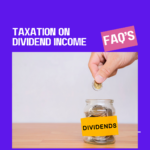What are the main advantages & disadvantages of ETFs?
| Aspect | Advantages | Disadvantages |
|---|---|---|
| Liquidity | Traded like stocks, allowing easy buying and selling throughout the day. | Some ETFs, especially sector-specific ones, may have low trading volumes, leading to liquidity concerns. |
| Diversification | Provides exposure to a broad range of assets (stocks, bonds, commodities) in a single investment. | Unlike actively managed funds, ETFs typically track an index and lack active stock selection. |
| Lower Costs | Lower expense ratios compared to mutual funds due to passive management. | Brokerage fees and bid-ask spreads can add costs, especially for frequent traders. |
| Transparency | Holdings are disclosed daily, allowing investors to see what they own. | Actively managed ETFs may not disclose holdings as frequently. |
| Tax Efficiency | Lower capital gains tax compared to mutual funds due to in-kind creation/redemption process. | Dividends received are taxable, and capital gains tax applies if sold at a profit. |
| Flexibility | Can be traded anytime during market hours at real-time prices. | Unlike mutual funds, which trade at NAV at the end of the day, ETFs can experience price deviations from NAV. |
| Dividend Payments | Many ETFs pass on dividends to investors, creating an income stream. | Dividend yields may be lower compared to direct stock investments. |
| Risk Management | Offers built-in diversification, reducing stock-specific risk. | ETFs still carry market risk, and sector-specific ETFs can be highly volatile. |
How can investors buy and sell ETFs?
ETFs are traded like stocks on stock exchanges, making buying and selling them easy and flexible. Here’s how investors can invest in ETFs:
1️⃣ Buying ETFs
✅ Step 1: Open a Demat & Trading Account
- ETFs require a Demat account and a brokerage account (Zerodha, Upstox, ICICI Direct, etc.).
✅ Step 2: Choose the Right ETF
- Research ETFs based on index tracking, sector focus, expense ratio, and past performance.
- Examples: Nifty 50 ETF, Gold ETF, Nasdaq-100 ETF.
✅ Step 3: Place a Buy Order
- ETFs trade in real-time like stocks.
- Investors can place market orders, limit orders, or SIP investments (if supported).
✅ Step 4: Settlement & Holding
- Purchased ETF units are credited to the Demat account within T+2 days.
2️⃣ Selling ETFs
✅ Step 1: Place a Sell Order
- Log in to the trading account and choose the ETF from holdings.
- Select the number of units and place a market or limit sell order.
✅ Step 2: Receive Funds
- The amount is credited to the linked bank account after T+1 settlement days.
Key Considerations When Trading ETFs
✔ Liquidity Matters – Choose ETFs with high trading volumes to avoid price discrepancies.
✔ Check Tracking Error – Lower tracking error ensures the ETF closely follows its benchmark.
✔ Market Timing – Unlike mutual funds (NAV-based), ETF prices fluctuate throughout the day.
✔ Brokerage & Charges – Some brokers offer zero or low brokerage fees on ETFs.
Can ETFs pay dividends?
Yes, ETFs pay dividends if the securities they hold generate income (e.g., stocks paying dividends or bonds paying interest). These dividends can be distributed directly to investors or reinvested back into the fund, depending on the ETF's policy.
What are the types of ETFs?
1. Equity ETFs
- Track stock market indices like Nifty 50, S&P 500.
- Provide broad market exposure with lower costs.
- Example: Nifty 50 ETF, Nasdaq-100 ETF.
2. Bond ETFs
- Invest in government, corporate, or municipal bonds.
- Provide fixed-income returns with lower risk.
- Example: Treasury Bond ETFs, Corporate Bond ETFs.
3. Sector & Industry ETFs
- Focus on specific sectors like technology, healthcare, banking.
- Ideal for investors bullish on a particular industry.
- Example: Banking ETF, Pharma ETF.
4. Dividend ETFs
- Hold stocks that pay high or stable dividends.
- Suitable for income-focused investors.
- Example: Nifty Dividend Opportunities ETF.
5. International ETFs
- Provide exposure to foreign markets and economies.
- Help diversify investments globally.
- Example: China Market ETF, US Market ETF.
6. Commodity ETFs
- Track the price of gold, silver, oil, natural gas, etc..
- Offer a way to invest in commodities without holding physical assets.
- Example: Gold ETF, Crude Oil ETF.
7. Real Estate ETFs (REIT ETFs)
- Invest in Real Estate Investment Trusts (REITs).
- Provide exposure to rental income and property appreciation.
- Example: REIT ETFs in commercial properties.
8. Thematic ETFs
- Focus on long-term investment themes like ESG (Environmental, Social, Governance), AI, Clean Energy.
- Suitable for investors betting on future trends.
- Example: Green Energy ETF, Technology Innovation ETF.
9. Currency ETFs
- Track the value of currencies like USD, EUR, JPY.
- Used for forex exposure or hedging currency risks.
- Example: USD ETF, Euro ETF.
10. Leveraged ETFs
- Use financial derivatives to amplify returns (2x or 3x exposure).
- High risk, meant for short-term traders.
- Example: 2x S&P 500 ETF.
11. Inverse ETFs
- Designed to profit from market declines.
- Move opposite to the index they track.
- Example: Inverse Nasdaq ETF.
What are leveraged and inverse ETFs?
- Leveraged ETFs: These aim to amplify the returns of an index (e.g., 2x or 3x the performance of the index). They use financial derivatives and are best for short-term trading due to their high-risk nature.
- Inverse ETFs: These provide returns opposite to the performance of an index, allowing investors to profit when markets decline. They are also more suitable for short-term strategies.
How are ETFs different from mutual funds?
| Aspect | Exchange-Traded Funds (ETFs) | Mutual Funds (MFs) |
|---|---|---|
| Trading Method | Traded like stocks on stock exchanges throughout the day. | Bought and sold through AMC (Asset Management Company) at the end of the day at NAV. |
| Pricing | Prices fluctuate in real-time based on market demand and supply. | Priced at Net Asset Value (NAV), determined once at the end of the trading day. |
| Management Style | Mostly passive management (track an index like Nifty 50, S&P 500). | Can be actively or passively managed, depending on the fund type. |
| Expense Ratio | Lower expense ratio (0.05% – 0.75%) due to passive management. | Higher expense ratio (0.5% – 2%) due to fund manager involvement. |
| Liquidity | Highly liquid – can be bought/sold anytime during market hours. | Less liquid – can be redeemed only at day-end NAV. |
| Minimum Investment | No fixed minimum; can buy 1 unit like a stock. | Typically requires a minimum investment of ₹500 – ₹5,000 (lump sum or SIP). |
| Lock-in Period | No lock-in period for most ETFs. | Some MFs (like ELSS funds) have a lock-in period of 3 years. |
| Dividend Handling | Dividends are credited directly to investors or reinvested based on preference. | Dividends can be paid out or reinvested within the mutual fund. |
| Tax Efficiency | More tax-efficient; lower capital gains tax due to in-kind creation/redemption process. | Higher capital gains tax impact due to frequent buying/selling within the fund. |
| Mode of Investment | Requires demat account & brokerage account. | Can invest directly via AMC, banks, or online platforms without a demat account. |
| Customization | No customization; follows the index or theme. | Actively managed funds allow professional stock selection. |
Are ETFs suitable for all investors?
ETFs can be a great investment tool, but their suitability depends on an investor’s financial goals, risk appetite, and investment knowledge.
✅ ETFs Are Suitable For:
- Long-Term Passive Investors – Those looking for low-cost, index-based investing with steady growth.
- Beginners & First-Time Investors – Provides diversification with a single purchase, reducing risk.
- Cost-Conscious Investors – ETFs have lower expense ratios compared to mutual funds.
- Traders & Active Investors – Can be bought/sold in real time like stocks, allowing strategic trading.
- Diversification Seekers – ETFs offer broad exposure to markets, sectors, and commodities.
- Tax-Efficient Investors – Lower capital gains tax impact compared to actively managed mutual funds.
❌ ETFs May Not Be Suitable For:
- Investors Without a Demat Account – ETFs require a demat & brokerage account for trading.
- Those Seeking Professional Management – Unlike mutual funds, ETFs lack active fund management.
- Small or SIP-Based Investors – Mutual funds allow Systematic Investment Plans (SIP), but most ETFs do not.
- Investors Uncomfortable with Market Volatility – ETFs trade in real-time, leading to price fluctuations during the day.
- Illiquid Market Traders – Some sector- or theme-based ETFs have low trading volumes, making it difficult to buy or sell at the desired price.
What factors affect ETF prices during market hours?
1️⃣ Underlying Asset Prices – ETF prices move with the stocks, bonds, or commodities they track.
2️⃣ Supply & Demand – High demand pushes prices above NAV, low demand creates discounts.
3️⃣ Net Asset Value (NAV) – The ETF price should closely follow its NAV, but deviations occur.
4️⃣ Market Liquidity & Volume – Highly liquid ETFs have tight bid-ask spreads, making trading smoother.
5️⃣ Tracking Error – A large gap between ETF performance and its benchmark affects pricing.
6️⃣ Macroeconomic Events – Interest rates, inflation, and geopolitical news impact ETFs.
7️⃣ Currency Fluctuations – Affects international ETFs when forex rates change.
8️⃣ Arbitrage – Traders buy/sell ETFs to keep prices aligned with NAV.
What role do ETFs play in passive investing trends?
ETFs have become the backbone of passive investing, offering a low-cost, diversified, and efficient way to invest. Here's how they contribute:
1️⃣ Low-Cost Investing
- ETFs have lower expense ratios (0.05% – 0.75%) compared to actively managed funds.
- Reduces the impact of fees on long-term returns.
2️⃣ Index Tracking & Market Exposure
- Most ETFs track an index (Nifty 50, S&P 500, Nasdaq-100), eliminating the need for stock picking.
- Provides broad exposure with a single investment.
3️⃣ Diversification & Risk Reduction
- Investing in ETFs spreads risk across multiple stocks, sectors, or asset classes.
- Protects investors from individual stock volatility.
4️⃣ Liquidity & Flexibility
- ETFs trade like stocks throughout the day, unlike mutual funds (NAV-based).
- Investors can enter/exit positions easily.
5️⃣ Tax Efficiency
- Lower capital gains tax impact compared to mutual funds due to the creation/redemption process.
- Suitable for long-term investors seeking tax-efficient wealth building.
6️⃣ Growth of Smart Beta & Thematic ETFs
- New ETFs focus on factors like value, momentum, ESG, and sector-specific growth.
- Enables passive investors to customize portfolios based on trends.
7️⃣ Increasing Retail & Institutional Adoption
- ETFs are now widely used by both individual investors and large institutions.
- Growth in SIP-based ETFs, fractional investing, and robo-advisors is boosting accessibility.



